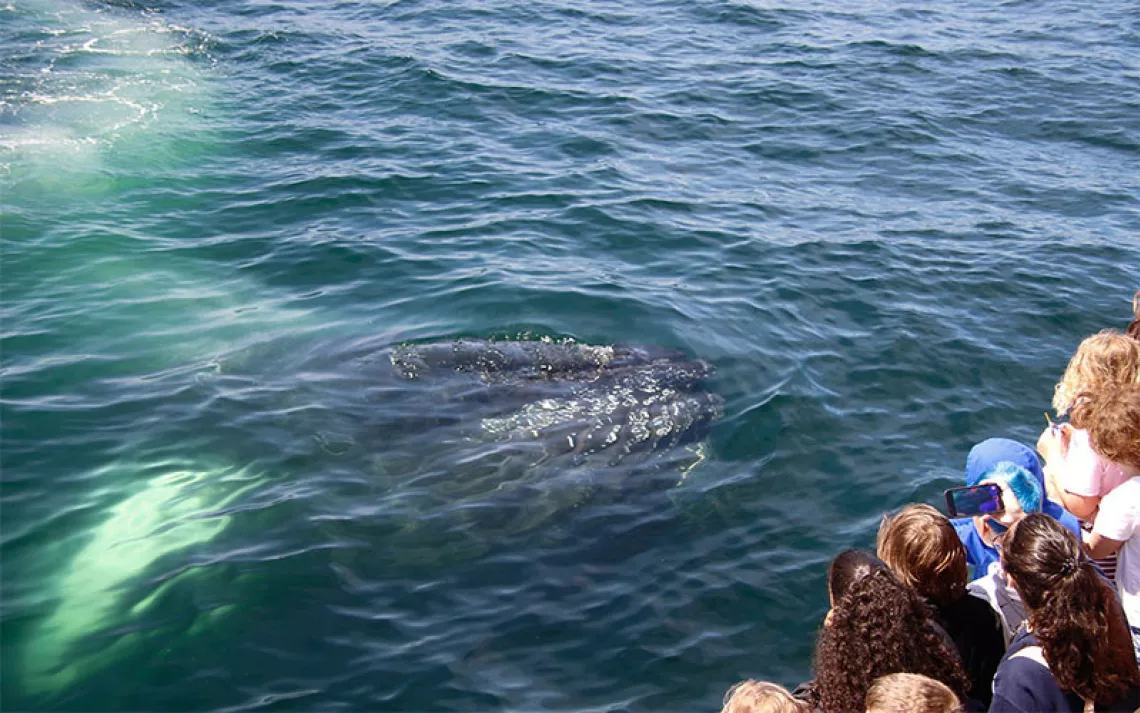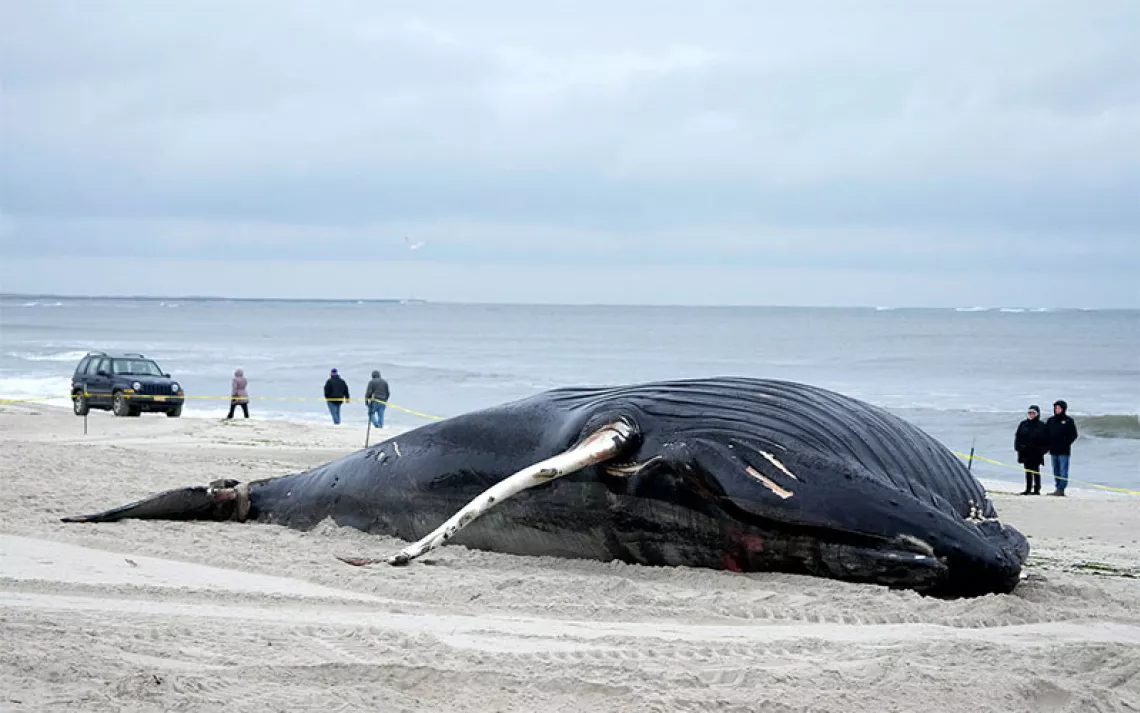Whale Hunters Defend the Grind in "Islands and the Whales"
New documentary takes an unflinching look at the whale hunts of the Faroe Islands

Photos courtesy of Mike Day
The Faroe Islands—an archipelago of 18 islands adrift in the North Atlantic between Scotland and Iceland—are home to people who have hunted the long-finned pilot whale since the days of their Viking ancestors.
The opening scenes of the documentary feature film The Islands and the Whales make it clear why—the islands, rising tall out of a dark sea, are so forbidding and isolated that it seems extraordinary that any community could have survived here.
An aerial shot lingers over them, then cuts to a stream of islanders running down to the shore, where distant black shapes thrash in a sea that soon turns red with blood. This is the grindadráp, or grind, the traditional whale hunt that has sustained these remote islands for centuries but now puts them at odds with the wider world.

The Faroe Islands
Director Mike Day has covered this territory before. His 2010 film The Guga Hunters of Ness followed a group of hunters from the Scottish island of Lewis who continue a centuries-old tradition of gannet-hunting on the remote, unforgiving island of Sula Sgeir; hunting is permitted on cultural grounds but condemned by animal rights groups. While opposition to the hunt was only briefly touched upon in Guga Hunters, it grounds the narrative in The Islands and the Whales.
Type “Faroe Islands” into a search engine and between images of the islands’ remarkable landscape you'll see photographs of the whale slaughter accompanied by calls to boycott the nation. These photos appear, too, in the comments on the Faroe Islands tourism board’s Facebook posts.
The photographs, filled with blood and death, have a purpose. They are meant to shame the Faroese and horrify anyone who comes across them. The Islands and the Whales doesn’t shy away from such imagery but presents it without emotion. The grind happens much the same way that it has for a thousand years: A flotilla of fishing boats traps a whale in a shallow bay, where it is slaughtered with knives.

At the end of a pilot whale hunt, hundreds of people head to the beach, eager to get a free share of the meat.
The camera impassively hangs over bloody water and the flecks of blood on hunters’ faces. A hunter stands still in the sea, up to his thighs in blood, and the microphone picks up the high-pitched moans of the whales as they are slaughtered. Unlike other, less controversial farming practices, the slaughter takes place in public. Each stage is shown, from the hunt to the killing and the dividing up of the meat among the community.
In the middle of the film, black Sea Shepherd vans roll in to the capital of Tórshavn, looking like an invading army. Their skull and crossbone flag is a sore point. It “brings bad times to mind,” says one Faroese man over coffee with his friends. “We’ve had bad experiences with pirates in the past.”
Sea Shepherd holds a press conference at the Hotel Tórshavn, led by Pamela Anderson. A local asks her what she suggests the Faroese should eat instead of whale, and if the Sea Shepherds would leave them alone if they imported American cows and killed them instead. Anderson responds, “Be vegetarian!”
It’s easy to laugh at the naiveté of the Sea Shepherds. But the pain on the activists’ faces as they are led away by police from the shore after failing to stop a whale killing is palpable. This issue has deep personal investment on either side, and neither, at its core, is wholly rational.
Sea Shepherd’s argument is an emotional appeal. The Faroese have a good argument that hunting the pilot whale is one of the islands’ few sources of food and therefore critical to their survival. But they also seem concerned with its intangible significance. The end of the grind, says one, would mean that “this small nation would have lost an integral part of its nationhood.”
But there is a rational, critically serious argument for ending the practice. For the past decade, Pál Weihe, chief physician of the Department of Occupational and Public Health, has warned the Faroese that pilot whale meat now contains too much mercury, PCBs, and DDT derivatives to be safe for human consumption. Weihe is hopeful that, as a Faroese himself, people will listen to him.
And yet, like the hunter thigh-deep in bloody water, everyone in the film seems to be intent upon standing their ground. The Sea Shepherd representatives won’t consider the islanders’ questions. A young father won’t listen to Weihe when he advises him to stop eating whale (“Pál is not going to decide whether I eat it or not,” he says), and the elders, who have eaten whale their entire lives, refuse to even have their mercury levels tested. The condemnation of the outside world seems to have left the younger generation determined to make sure the grind continues. “They awoke the interest of our young people” says one man, “because another way of life is being forced on them.”
The islanders’ fight to preserve their tradition looks futile. Yet the viewer might sympathize with the Faroese; after all, they didn't pollute the ocean. The Faroese, says Weihe, “have a strong case to accuse the outside world of polluting our seas, which we have been harvesting for centuries.”
Throughout the film, a voice-over tells the story of the huldufólk, the “hidden people” of Faroese folklore who respected nature and took care of it, but who are said to have disappeared when electricity came to the islands. With legends like these, the film could have easily leaned on a folksy representation of the Faroese as a nature-respecting people who have had their environment destroyed by the outside world. But it doesn’t let them off so easily, highlighting their past overhunting of puffins to illustrate that, in the words of one Faroese, they “are certainly not angels.”
For all the sweeping shots of dramatic Faroese landscapes, it is the small, intimate scenes that are most affecting. Those scenes, in which families discuss their mercury levels around the dinner table and a doctor snips off a lock of a young girl’s hair to test, bring home a sense that this should not just be a battle of ideas, that people’s lives are at stake.
In a scene shot in a family’s living room, a newsreader reports on the aftermath of the grind and asks, “Who won? The Faroese or Sea Shepherd?” It is a question without an answer. Neither side comes out of the film vindicated. These islands may be remote—and the issue may seem a distant one—but their remoteness is no buffer against the rest of the world.
“Maybe we should be a barometer for the rest of the planet,” says one man. “There are no industrial countries nearby, so if our food is so contaminated by them, it must be really bad elsewhere.”
The Islands and the Whales will be broadcast on PBS October 9 and will be available to stream for free here.
 The Magazine of The Sierra Club
The Magazine of The Sierra Club



